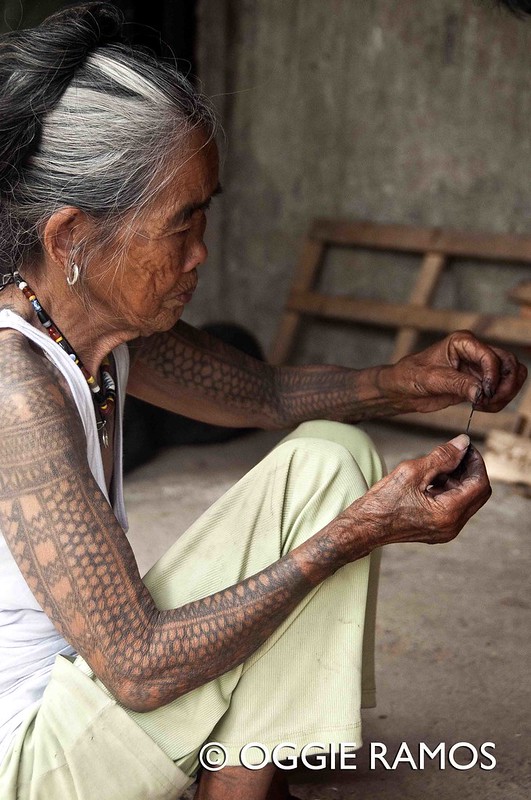 |
| 93 years old mambabatok, Fang-od |
To find out, we hiked for over three hours from the barangay of Bugnay to the mountain village of Barangay Buscalan; elevation: give or take 3200-3300 feet above sea level (sorry, wasn't able to calibrate my watch properly after battery replacement); households: 126; voting population: 668.
The jump-off point of our trek is Bugnay, famous (or infamous, depending on your perspective) as the birthplace of Macli-ing Dulag (see previous post for a bit of the backstory), the tribal chief who opposed the building of the large hydroelectric dam in Kalinga in the 1980s and paid dearly for it with his life. It's an almost 45-minute jeepney ride from Tinglayan to Bugnay and though I'm digressing from my topic, the ride bears mention.
Contrary to being jaded after having seen quite a bit of the Ifugao scenery, I continue to be amazed by what I see here. The morning we set out, the weather was fair, an excellent excuse as any to go toploading (in local parlance, it means riding on top of a public utility vehicle), all the better to see the breathtaking sights -- mainly, the rambling Chico River as it meanders and snakes its way through the lush valleys, and the imposing Sleeping Beauty mountain range which reveals its more pronounced anthropomorphic silhouette the farther you wander southwest.
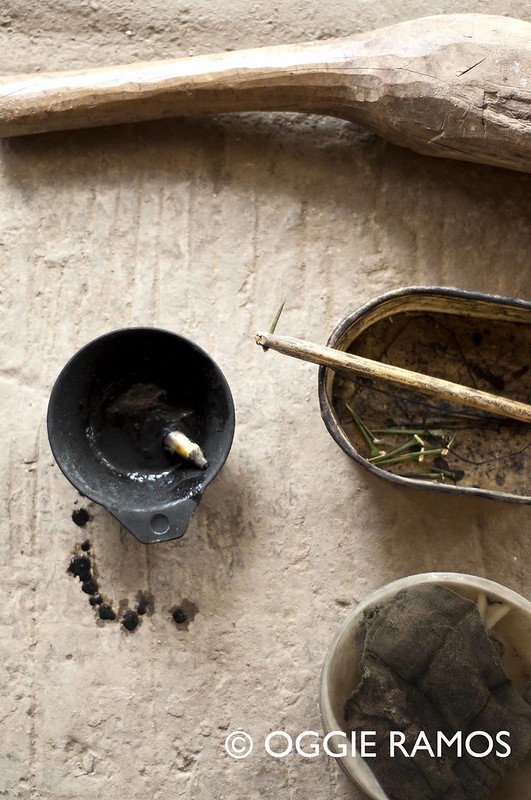 |
| Tools of the art: paddle, stick with kalamansi thorn, pattern maker, soot and rag |
After a quick lunch, it was on to the tattooing process. I distinctly remember Fang-od hauling a large spread of peanuts for storing before setting out looking for a wooden stick she can use as a hammer. She is incredibly strong and nimble for a woman (heck, for a man) of any age.
There was an ongoing construction near her house so we opted to have the tattooing just outside the house of her niece, Abu, where we were staying for the night. It was my friend who was going to get a tattoo and I will be the one to document it. The makeshift tattoo shop seemed to me like a veritable tableau of local color -- pigs freely snorting around, friendly dogs wandering in and out of sight, curious locals nonchalantly passing by throughout the almost two hour process.
 |
| After laying the pattern, Fang-od pokes the skin with kalamansi thorn |
Her memory is still as sharp as her skills, remembering vivid details from the distant past. We ask her what's the most elaborate design she did. Her answer: tattooing a woman's upper body which took all of two sunrises and sunsets to complete. Was there ever a time she wasn't able to complete a tattoo? Answer: only once, when a foreigner had tattooing done on his legs, the pain proving too much he passed out. Oh, we wanted to keep asking her questions but I guess that's the beauty of having only a day to spare -- so we can hopefully come back and inundate her with more questions.
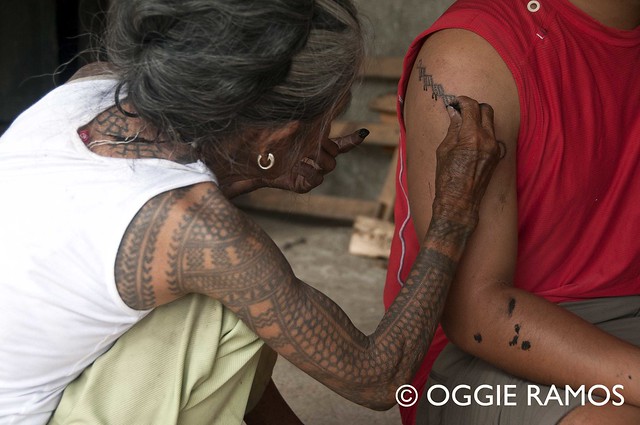 |
| Etching the finer details |
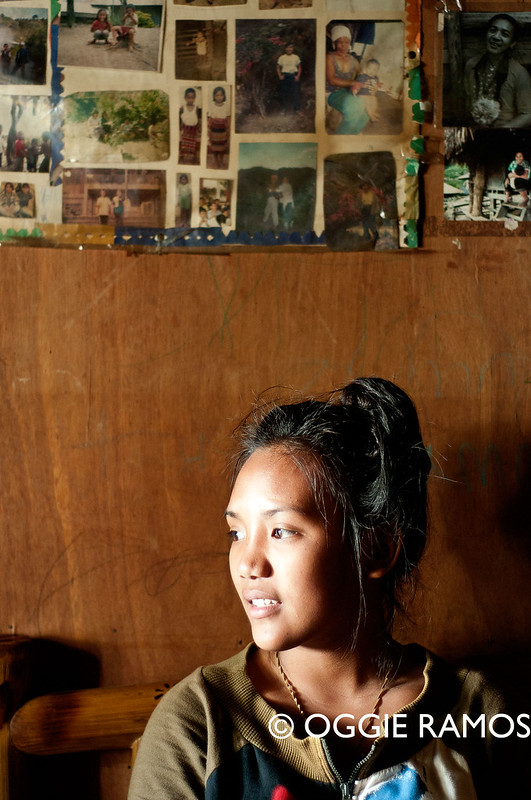 |
| 17 year old Grace Palicas carries on the legacy of her lola |
Grace does some of the tattooing of the visitors though not yet in the scale and intricacy of her lola. She, however, serves as an important bridge to the world outside Buscalan and Kalinga where she presents the tattooing art in the Dutdutan festival in Manila. Though far from frail, Fang-od almost never ventures outside Buscalan and Kalinga, feeling she might get sick from the pollution of the cities, our guide, Francis tells us.
The morning after, we were trekking back to Tinglayan via a traverse of the mountains for Liyao near Luplupa, when we heard shouts. It was Grace, energetically catching up with us carrying my camera's remote shutter release which I left behind. Francis joked she needed the early morning exercise. She only smiled in response. Why do I get the feeling she will play a very important part in carrying the legacy of her lola?
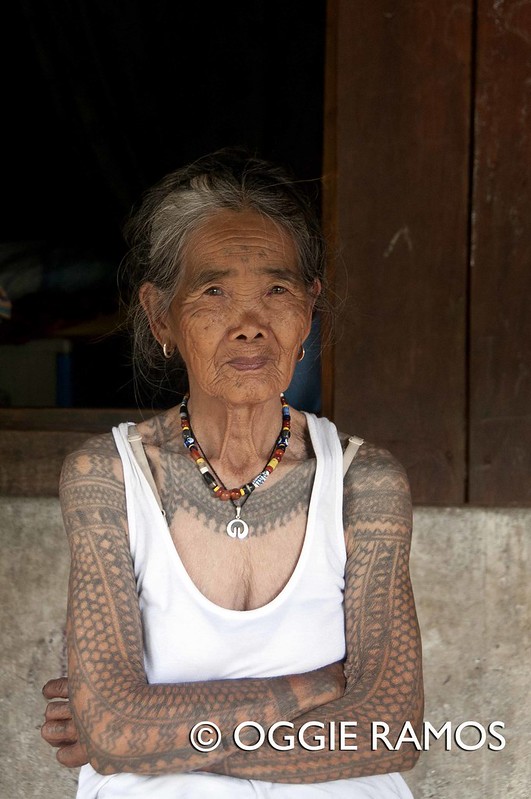 |
| Fang-od wearing the art of Kalinga tattooing |
In olden times, Lane Wilcken, author of the book "Filipino Tattoos, Ancient to Modern", writes, "one has to possess the qualities the tattoos represented prior to wearing them. The internalization of these traits or in other words, the tattoing of a person's soul was so important to possess before becoming tattooed. Without it, the marks on the skin are only vain decoration. Those men in the past who were tattooed without earning them were shamefully compared to the halo lizard which is richly patterned yet flighty and cowardly."
According to Lane, both men and women were tattooed -- "the women at puberty because of their innate power and connection to the ancestors through life-bearing. Men, in contrast, had to earn their tattoos." Talk about how vastly different the situation is now when one can get the kind of tattoo he/she wants, right down to the last detail, when he/she wants it.
What kind of ink? In ancient times, "tattoos symbolize the animal representatives of his ancestral spirits that guided his path as well as the gift of fertility and prosperity his actions provided. As a man went through life, each time he saw his tattoos, he was reminded to conduct himself in accordance with the prestige he had earned."
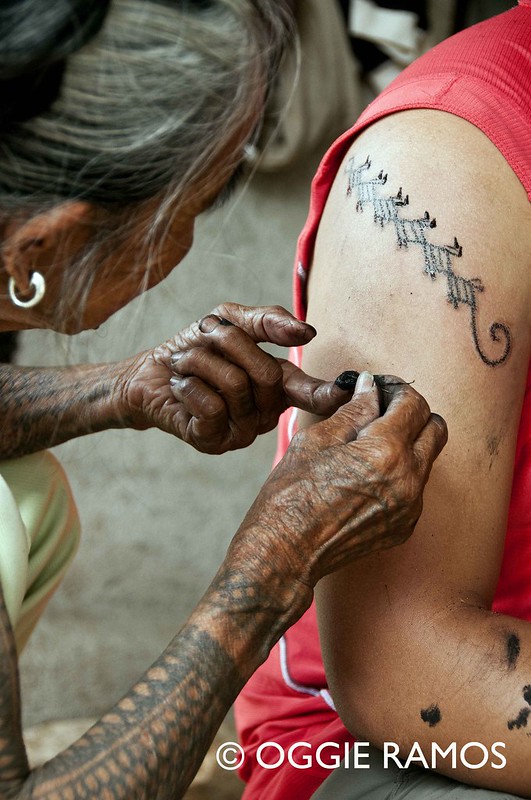 |
| Refining the pattern |
So where do you want your tattoo? In the past, the question of where you get tattooed is not a matter of personal choice or aesthetics; rather, it is of spiritual significance. Lane writes, "In general, the upper body (waist up) in many of our ancient cultural groups was associated with the earth world. A person's head was associated with the heavenly world as the seat of the soul. The lower body (waist down) was associated with the underworld and afterlife where our ancestors dwell."
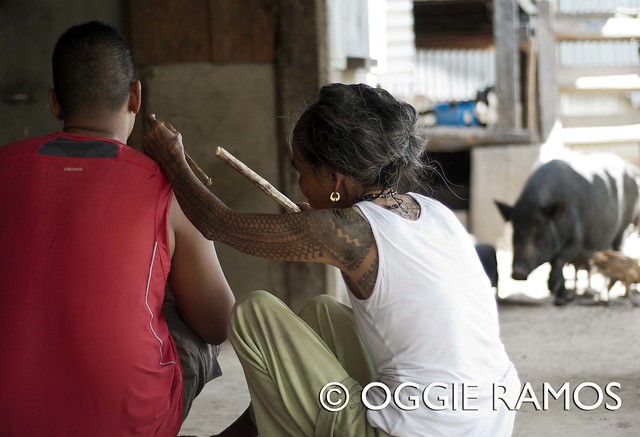 |
| Tattooing with the neighborhood pigs and chickens looking on |
Epilogue. In our day and a half stay in Buscalan , my friend got his tattoo while I was content to watch and shoot the process. While my personal religious convictions kept me from giving in to repeated goading and cajoling, I am well aware of tattooing's spiritual significance. It's amazing that in the several villages where we hiked to on our traverse of the mountains leading to Liyao and back to Tinglayan, the locals were still very much animated in seeing my friend's new tattoo as if it wielded some kind of power. Goes to show that back in the day, tattooing, like deep-seated beliefs, is more than skin-deep.
Directions: To get to Buscalan, take the jeepney headed for Bontoc from Tinglayan (8am and 1pm, 9am for the bus) and board off at Bugnay; jeepney fare: P20.
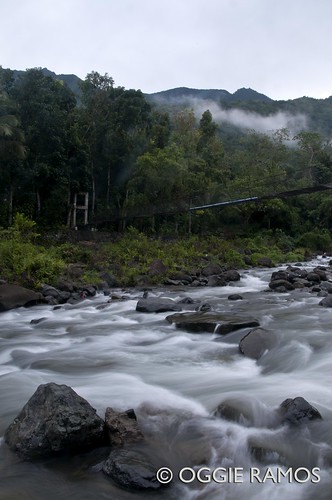
Read the related post:
Kalinga: Getting off the grid, ignoring the bed weather
and a bad rep in Tinglayan
Kalinga: Getting off the grid, ignoring the bed weather
and a bad rep in Tinglayan
